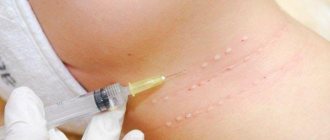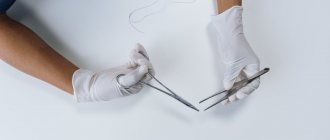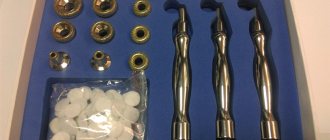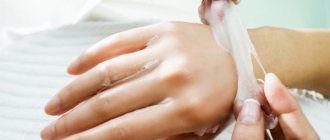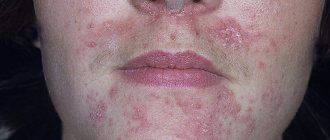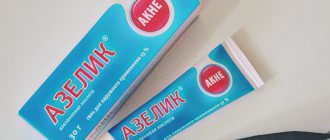Symptoms of seizures in the corners of the mouth
Clinical manifestations and symptoms of the lesion depend on many factors and stages. It usually begins with redness of the skin in the corners of the mouth, peeling, and the appearance of bursting blisters. Areas of erosion appear on the mucous membrane and skin of the corner, which become covered with a crust, when ruptured, cracks of varying depths can form.
In areas of inflammation, constant itching is felt, pain appears when opening the mouth, pain when eating spicy food. It is especially typical that a sharp pain appears in the morning, after sleep, when you first open your mouth.
But in some rare cases, obvious pain symptoms are mild, especially in elderly people, or in people suffering from diabetes mellitus (when seizures appear as a consequence of candidal stomatitis).
General recommendations from experts
The factors that most often provoke aging of facial skin include stress and bad habits. Habits can be easily broken, but stressful situations are difficult to cope with. Not everyone can quit their job, change society or place of residence. But you can minimize stress:
- It’s worth taking regular walks in the fresh air to restore the body’s resources;
- play sports, have physical activity;
- make your diet complete. Experts recommend eating more fruits and vegetables, this will fill the body with essential minerals and vitamins;
- sleep enough time. Healthy sleep has a positive effect on the condition of facial skin. You shouldn’t be stuck on your smartphone for a long time, but it’s better to go to sleep longer.
These are general tips that are best followed. After all, they can change your body and your skin for the better.
Causes of sticky spots in the corners of the mouth
for the appearance of seizures (more precisely, provoking factors) can be very diverse, although ultimately the cause is the action of microorganisms (i.e., infections) that cause limited inflammatory damage to areas of the skin and mucous membranes.
Bacterial infections. Mainly epidermal streptococci or staphylococci.
Fungal infections. Mainly by fungi of the genus Candida, sometimes against the background of candidal stomatitis.
Viral infections. Mainly by herpes simplex virus type 1, but more often against the background of herpetic stomatitis in the oral cavity. As a direct cause, they are less common.
The corners of the mouth are an almost ideal place for the accumulation and reproduction of microorganisms, which is facilitated by constant humidity, the presence of residual nutrients, and the relative enclosure of the space. But for the appearance of seizures in the corners of the mouth, provoking factors are necessary, which can be conditionally classified as external (for example, mechanical, local allergic, etc.) and internal (seizures as a manifestation of other diseases).
Dry mouth. Cracks in the corners of the mouth can be caused by excessive dryness of the oral mucosa (xerostomia).
Allergic reactions. For example, for cosmetics, for the components of ballpoint pens (if you have a habit of holding the tip in your mouth). But more often - on nickel-containing dentures.
Other external factors. As a rule, they contribute to bacterial infection in the corners of the mouth. Using dirty vegetables and fruits, regularly licking the corners of the mouth (which contributes to local stagnation of saliva), squeezing skin formations (such as pimples) on the lips, scratching this area, hypothermia of the entire facial area. External factors can also include long-term use of certain medications: antibiotics, hormone therapy drugs, as well as prolonged elevated body temperature.
General lesions of the oral mucosa. Inflammations of the oral mucosa of various types can lead to the appearance of jams in the corners of the mouth.
Common diseases as provoking factors. Among them: metabolic pathologies (for example, diabetes mellitus), Down syndrome (with an increased susceptibility to infections), Parkinson's disease (the corners of the mouth are constantly moist), various types of anemia (especially iron deficiency), immunodeficiency conditions, liver pathologies, hypovitaminosis ( deficiency of vitamin B2, B12, B6 or B3), lack of microelements in the body (zinc), pathologies of the gastrointestinal tract.
Cheilitis - symptoms and treatment
The lip consists of three sections: cutaneous, transitional (red border of the lips) and mucous. Deep in the lips is the orbicularis oris muscle, which is responsible for their movements.
The cutaneous section is similar to normal skin: it contains hair, sweat and sebaceous glands, and keratinizing epithelium. In the keratinizing epithelium, scales are formed that protect the underlying layers of the skin. Over time, the scales fall off and are replaced by new ones.
The transitional region is different from the skin: there is no hair and sweat glands, the sebaceous glands remain only in the corners of the mouth. They perform a protective function so that open areas of the lips do not dry out. The keratinizing epithelium gradually turns into non-keratinizing epithelium, i.e., protective scales do not form on it.
In the mucous membrane, the sebaceous glands completely disappear, the epithelium becomes non-keratinized and small salivary glands appear.
Cheilitis can be accompanied by various manifestations: scales, crusts, cracks, erythema, blisters and erosion.
Scales in cheilitis are silvery plates that form after the death and rejection of a layer of surface tissue. The keratinizing epithelium can only be seen under magnification, but the scales are immediately noticeable. They can also appear on non-keratinizing epithelium if its cells have died.
The next pathological element is the crust. It is similar to a scale, but is formed if the death of surface cells is complicated by inflammation. Fluid containing immune cells emerges from the blood vessels, and the scales swell and turn into crusts. Due to the fact that there is more fluid between the cells, the adjacent tissues increase. They begin to compress pain receptors, and pain occurs.
Cracks are painful defects in the form of straight lines. They occur when lips become dry and lose their elasticity. They can appear due to bad habits such as smoking and lip biting, as well as burns, physical and chemical trauma.
Cracks can heal and reappear after some time, often in the same place. This cycle can be seasonal, for example worsening in winter due to adverse weather conditions or weakened immunity.
Erythema is a red spot without clear boundaries, most often due to allergies. Usually painless, but sometimes its sensitivity increases slightly.
A vesicle is a small formation above the surface of the skin or mucous membrane. Inside it there is a liquid - blood plasma with living and dead immune cells and microorganisms; in more severe cases it is called exudate, or pus. The appearance of fluid is often preceded by an infection, to which the body's immune cells react.
Erosion is a pink or red formation that appears at the site of a large burst bubble. It is painful when touched. It differs from erythema by clearly defined boundaries and location below the level of the skin or mucous membrane, forming a small “pit”.
Complications of lip jams
At the first, initial stage, the superficial layers of the mucous skin are affected and timely treatment of the jam leads to a quick recovery. But if left untreated, the lesion spreads to the deeper layers of the skin with the formation of a deep crack in the corners of the lips and the participation of lymphatic capillaries. The lesion can spread to neighboring areas of the skin, new cracks form, they combine into a large wound, which requires separate and special treatment.
Cosmetological methods for reducing wrinkles around the mouth
- The use of cosmetics containing proteins collagen and elastin. Applying anti-wrinkle serums is the gentlest way to reduce the appearance of these lines. Skin care products can be very effective for mild to moderate wrinkles, but in severe cases their effectiveness is low. Since the skin around the lips and eyes is similar in its thinness, the serum can be used to hydrate and rejuvenate both areas of the face. Anti-aging biocreams based on natural ingredients - plant extracts, natural oils and extracts - work effectively.
- Introduction of fillers based on hyaluronic acid, which makes up a kind of “framework” of the skin. These preparations contain hyaluronic acid, which has a rejuvenating effect. As a result, not only wrinkles disappear, but also the skin looks younger.
- Injection of filler into the lips - the procedure eliminates wrinkles and makes lips plump and attractive.
- Microneedling is a procedure in which the skin is pierced with a large number of small needles. As a result, metabolic processes are enhanced, which leads to skin rejuvenation due to regeneration. Microneedles are used not only in the lip area, but also on the entire face, so the procedure works as a “reboot” of the skin, interrupting the natural aging processes.
- Botox injections. Reduce the movement of the orbicularis oris muscle, allowing you to smooth out wrinkles around the lips and prevent their appearance. The drug must be injected into this area very carefully, since an overdose leads to impaired muscle function. Drooling occurs when drinking and the pronunciation of some letters changes. Botox not only helps get rid of existing wrinkles, but also effectively prevents the development of new ones.
- Laser treatments that remove dead skin cells and promote the growth of healthy ones underneath. Depending on the depth of the folds, one or more of these procedures will be required.
- Chemical peeling and dermabrasion are procedures during which the epidermis, the top layer of skin, is cleansed. Stimulates the production of collagen and elastin, helping to strengthen the skin framework. They are great for removing shallow wrinkles, but they are not very suitable for deeper wrinkles.
Wrinkle treatment results before and after filler injections

